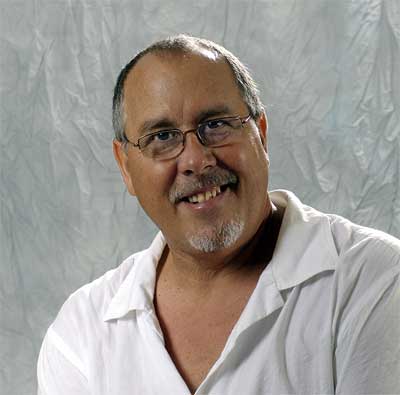Images from the Frank Stick and Rockefeller Family Archives
Publisher[1], Producer, and our Speaker
(Presented by Steve Simonsen, summarized by Robin Swank)
A standing-room–only crowd of over 100 Members and guests greeted Steve Simonsen at lovely Bethany Church Hall for the first Membership meeting of the season. Steve presented four films and four series of ’stills’ to a variety of tunes), that Board member Bruce Schoonover collected and compiled in connection with his research into the establishment of the Virgin Islands National Park.
Our power–packed evening at the movies, with popcorn provided by Margie Labrenz, began with an early 1950’s color movie from the Rockefeller archives. Pristine landscapes abound; the shorelines are empty—the McCully house is the only one visible in one wide–angle shot. A somewhat tumbledown Reef Bay House (which we will visit on our February trek), looks much like it does today. In town, at the dedication of the Park, the entire St John population, along with half of St Thomas, appears to have shown up–hatted ladies & linen-panted men sample the food and listen to speakers and steel pan. Images of poinsettias, ginger thomas, and flamboyant flowers, the vistas from Reef Bay, and a particularly wonderful face of a St. John elder with his pipe are captured.
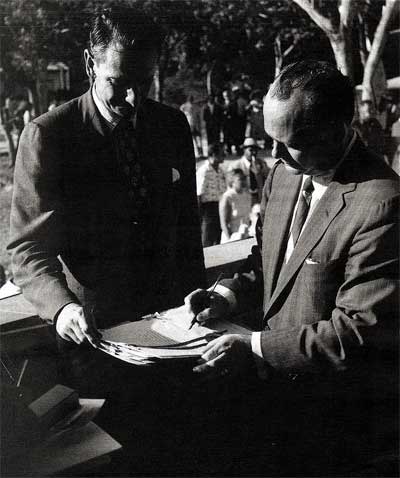
Laurance S. Rockefeller presenting Fred
Seaton, Secretary Dept. of Interior with
deeds for 5,095 on St. John
Frank Stick, one of the originators of the idea of a St. John park, and later the person who negotiated purchases on behalf of the formation effort, was the creator of the second film, shot in 1953. Although faded, its 8 minute encapsulation of the tranquility and beauty of St John’s landscapes and people, and the many scenes of the 1400+ acres of his bush–free Lameshur Estate (manicured by several generations of cattle) are soothing. As Steve pointed out, you can still recognize some of the same rocks and trees today. There are many shots of the Lameshur factory and Estate House. You get the impression that life was smooth sailing in those days, watching the local boats motor and sail in Lameshur Bay.
Our Short Feature of the evening was “The Gem of the Caribbean”, produced by Universal Films (Charles W. Herbert) in the 1930’s. It depicts Hollywood’s idea of what might appeal to State–siders wanting a romantic getaway. “St. John, this tropical paradise,” gushes the narrator, is “due to become the American Bermuda.” An undeveloped St. John serves as backdrop to fully–attired men and women cavorting on the beach, riding horseback on the sand, and wading in the shallows with torches at sunset to catch long–as–your–arm lobsters for dinner. Gentlemen lug their ladies from boat to shore at ‘colorful Hawksnest Bay’ so they don’t get their stockings and skirts wet. One needs to ignore this staged silliness, made ugly by the narrator’s labeling the times of slavery on the ‘romantic’ colonial plantations as ‘that golden era,’ to see the film as the invaluable period piece it is. Contrasting the ribbon of dirt track that was the North Shore Road, the clean simple lines of the dock and ruins at Caneel, and the boat and villa–free vistas from the film with today’s modern improvements, makes us thankful that the Park’s formation preserved a piece of an earlier paradise.
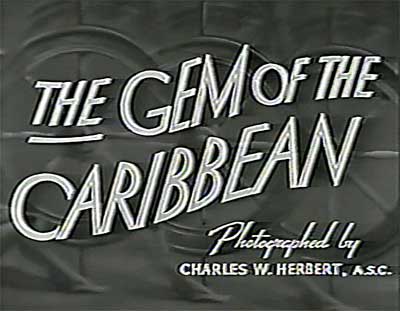
The fourth film, covering the ceremony of the dedication of the National Park, came from the Rockefeller archives. Steve presented portions of film not used in creating the DVD, The Establishment of Virgin Islands National Park.[2]The film begins with CaribAir dropping dignitaries at the de minimus airport on St. Thomas. The Stars (48) & Stripes flies over the assembled dignitaries as the deeds are presented. Many splendid views of unspoiled St. John are testament to what the people of that time wanted to preserve by assembling the land parcels for the establishment of the Park
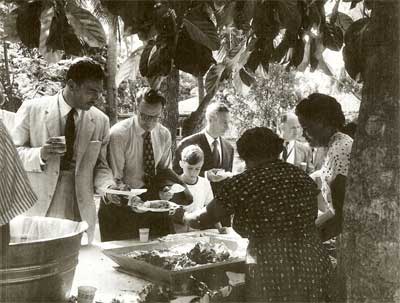
Buffet line at Park Dedication with Rep. Adam
Clayton Powell, Jr. and LSR being served.
Steve assembled the ‘stills’ with entertaining Stateside 1950’s rock music. Of course the audience knew most of the words—and some sang surreptitiously along as the themes of the four sets of photos–Caneel Bay, Coral Bay/East End, Cruz Bay, and People—played out. Stills of the Caneel grounds, Cinnamon Bay, Fortsberg, the Moravian church, and Annaberg accompanied lyrics “See the pyramids along the Nile—- You belong to me” and “So this is Love”. Chubby Checker ‘twisted last summer’ as Love City’s 1940 Cruz Bay Dock, and a US Post Office and Visitors’ Center, circa 1950, welcomed visitors simply and warmly.
The audience hummed along with “Only You…can make my dreams come true” to images of buttressed silk cotton trees. The lyrics “You are My Destiny…” accompanied the image of a Virgin Islands Park jeep in an early 1960’s July 4th parade.
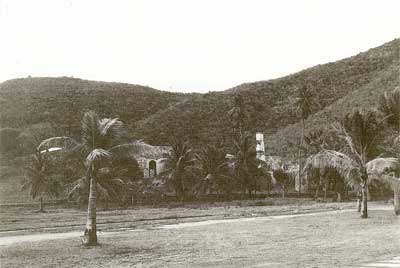
Caneel Ruins, c1954
The evening closed with the Interviews and Credits from the trailer of The Establishment of Virgin Islands National Park.[1] It was inspiring to hear St. John Historical Society Board members Andromeada Childs, David Knight, Eleanor Gibney, and Elroy Sprauve rejoice in the beauty of the island, and applaud the idea that preservation of the land helps to preserve the St Johnian heritage, enabling future generations to share in the joy of growing up on St. John.
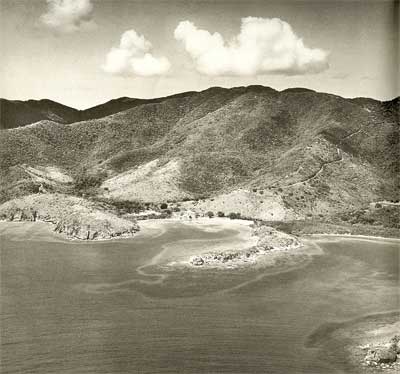
Lameshur Estate, c1956
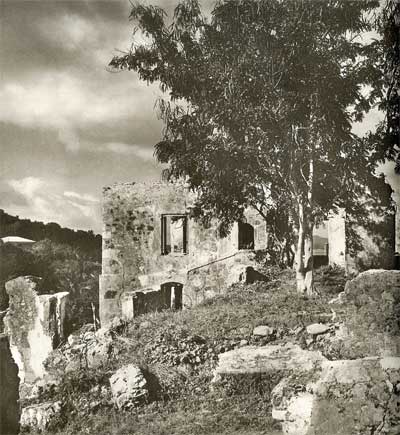
Plantation house at Caneel, c1956
- Steve Simonsen’s dazzling Living Art, St. John, which can be ordered on line at www.stevesimonsen.com , is now five years old. It is, he hopes, a time capsule of St. John, one that will evidence ‘no change’ to the island when it is opened fifty years hence.↑
- This film by Bruce Schoonover, Steve Simonsen & William Stelzer, © 2006, produced by Friends of Virgin Islands National Park, details the activities which stand behind the somewhat simplified statement:“Rockefeller bought up all the land and established the VINP.” The film is available on the ‘Friends’ web site, the ‘Friends’ store and at a number of St. John establishments.↑

